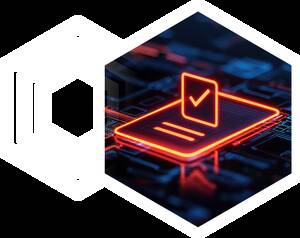Implementing Control Frameworks

How to successfully implement a cybersecurity framework in healthcare
Adopting a cybersecurity framework is a crucial step in strengthening the security posture of healthcare organizations, but choosing the right framework is only the first step. The next challenge lies in how to implement it effectively. Implementing a cybersecurity framework requires thoughtful planning, adequate resources, and a clear strategy, especially considering the unique challenges healthcare organizations face, such as budget constraints, regulatory complexity, and the need for continuous adaptation in a rapidly changing digital environment.
This section walks through Coalfire’s key considerations and best practices for successfully implementing a cybersecurity framework in healthcare, focusing on critical factors such as budget, organizational size, available resources, and the necessary steps to ensure long-term success.
Assessing your current security posture
Before diving into the implementation of any cybersecurity framework, the first step is to assess your organization’s current security posture. This means understanding where your organization stands in terms of risk, existing controls, and potential vulnerabilities. The goal is to determine how far your current security policies, tools, and procedures align with the standards set by your chosen framework. Key considerations for assessment include:
- Conducting a gap analysis: Compare your current security practices against the framework’s guidelines. Identify areas where your organization is already compliant and areas where improvements are needed.
- Performing a risk analysis: Understand the specific risks, threats, and vulnerabilities that your organization faces, from data breaches and ransomware attacks to insider threats and non-compliance with regulations like HIPAA. The U.S. Department of Health and Humas Services Office of Inspector General (OIG) is placing an emphasis on the importance of a formal compliance risk assessment being included in as part of a compliance program.
- Involving stakeholders: Include key departments in this assessment (e.g., IT, legal, compliance, and executive leadership) as each will have different insights into various aspects of your organization’s security needs.
An accurate assessment will help you allocate resources more effectively and make informed decisions about the implementation process. Coalfire offers both security risk analysis and gap analysis services that are scalable and can be scoped to organizational needs.
Define clear objectives and scope
When implementing a cybersecurity framework, it is important to establish clear objectives and define the scope of the initiative. A well-defined plan ensures that resources are allocated effectively and that everyone in the organization understands the importance of the project. Key considerations for defining objective and scope include:
- Setting specific goals: Are you looking to achieve certification (e.g., HITRUST), enhance regulatory compliance (HIPAA), or simply improve overall risk management? Clearly define what success looks like for your organization.
- Establishing scope: Consider whether the framework will apply to your entire organization or just specific departments (e.g., IT, clinical operations, or vendor management). Some organizations start with a pilot project in a high-risk department, such as billing or patient data management, before scaling the framework across the entire organization. You also must consider, at a minimum, where your organization stores its PHI.
For example, if you are a smaller hospital with limited resources, starting small and gradually expanding may be a more manageable approach than attempting to roll out an enterprise-wide overhaul all at once.
Assess your budget and resource constraints
One of the most common barriers to implementing a cybersecurity framework in healthcare is budget. Healthcare organizations, especially smaller ones, often operate under tight financial constraints. Implementing a robust cybersecurity program can be expensive, but it is essential to view this investment as a long-term strategy to protect patient data, avoid costly data breaches, and ensure compliance with regulations. Key considerations for budgeting include:
- Determining your budget: Start by allocating a budget specifically for cybersecurity initiatives. Include both one‑time costs (such as consulting or technology purchases) and ongoing costs (such as software subscriptions, staff training, and regular audits).
- Prioritizing funding: Based on your risk assessment and gap analysis, prioritize funding for the areas that will have the greatest impact. For example, if you have outdated security tools, investing in new firewalls or endpoint protection may be a priority.
- Considering external support: Many healthcare organizations leverage external vendors or consultants to help implement frameworks. Outsourcing certain aspects of the implementation (e.g., risk assessments, training, or technical support) can help reduce costs, especially if your in-house team lacks expertise.
- Leveraging grants or funding: Some government programs or industry organizations offer grants or funding opportunities to help healthcare providers improve their cybersecurity posture. Be sure to explore these options to stretch your budget further.
If resources are limited, focus on the most pressing cybersecurity issues first, such as securing patient data and ensuring compliance with HIPAA, before expanding to other areas like medical device security or supply chain risk management.
Allocate internal resources and build a strong team
Successful framework implementation requires a dedicated team, including individuals with expertise in cybersecurity, risk management, compliance, and IT. However, the size and structure of the team will vary depending on your organization’s size and resources. Key considerations for internal resource allocation include:
- Designating a cybersecurity leader: Appoint a Chief Information Security Officer (CISO) or (a) cybersecurity manager(s) who will be responsible for driving the framework implementation. This person should have a deep understanding of both cybersecurity best practices and healthcare regulations and be identified as the official for the implementation of security policies and procedures.
- Developing cross-department collaboration: Involve key stakeholders from departments such as legal, IT, compliance, operations, and clinical teams. Cybersecurity in healthcare is not just an IT issue; it is an organizational-wide responsibility.
- Ensuring proper training: Employees across all departments need to understand their role in maintaining security. Provide regular cybersecurity training, focusing on topics like phishing prevention, password management, and data privacy. Consider utilizing resources like security operations centers (SOCs) for continuous monitoring if your budget allows.
Building a strong internal cybersecurity team can help ensure that the framework is implemented successfully and that ongoing risk management efforts are sustained.
Develop a roadmap for implementation
A detailed, step-by-step roadmap is essential for guiding the implementation process and ensuring that it stays on track. A well-structured roadmap allows you to break down complex tasks into manageable phases and set clear milestones for each stage of the implementation. Key considerations for implementation planning include:
- Breaking it down into phases: Rather than attempting to implement the framework all at once, divide the process into phases. For example, Phase 1 could focus on risk identification and assessment, while Phase 2 could address incident response procedures and technology upgrades.
- Setting realistic milestones: Create achievable goals for each phase. For example, completing a risk assessment within 30 days or implementing employee training within 90 days. These milestones should align with your overall objectives and help you measure progress.
- Monitoring and adjusting: Regularly review the roadmap and adjust it as needed based on changes in your organization’s priorities, available resources, or evolving cybersecurity threats. Flexibility is key to successful implementation.
Ensure that each phase is properly resourced and that the necessary tools, personnel, and budget are in place before moving to the next stage.
Continuous monitoring and improvement
Cybersecurity is not a one-time project; it is an ongoing process. Even after you have successfully implemented your framework, it is important to monitor progress, identify areas for improvement, and update your security posture as new threats emerge. Key considerations for monitoring and improvement include:
- Establishing a feedback loop: Use regular audits and assessments to evaluate the effectiveness of your framework implementation. Are you meeting your goals? Are there any gaps or new risks that need to be addressed?
- Conducting regular training and awareness programs: As cybersecurity threats evolve, so should your organization’s knowledge and practices. Implement periodic training to keep employees updated on new threats, policies, and best practices.
- Adapting to new regulations and standards: Cybersecurity is an ever-changing landscape, especially in healthcare where new regulations and guidelines frequently emerge. Ensure that your framework remains adaptable to changes in the regulatory environment.
Make cybersecurity a continuous focus within your organization. By maintaining a proactive approach and regularly reassessing your security posture, you will ensure that your healthcare organization is better equipped to handle future risks.
Examples of popular cybersecurity frameworks
Choosing the right cybersecurity framework is crucial for healthcare organizations looking to secure sensitive patient data and ensure regulatory compliance. A well-established framework can provide a structured approach to identifying risks, implementing security controls, and responding to incidents. One of the most widely recommended frameworks and a best practice for healthcare organizations is the NIST RMF. The NIST RMF offers a comprehensive and systematic approach to securing information systems, making it especially suitable for healthcare environments that must navigate complex regulatory requirements like HIPAA.
The subsections below provide further information on some of the most widely recognized frameworks used in healthcare organizations:
NIST RMF
The NIST RMF is a structured process designed to guide organizations in managing cybersecurity risks throughout the life cycle of an information system. It can be particularly relevant for healthcare organizations because it focuses on applying a risk-based approach to security, helping ensure that sensitive PHI is protected in alignment with regulatory requirements such as HIPAA. NIST RMF:
- Offers a comprehensive set of controls for all system types
- Is risk-based and flexible
- Is directly applicable to federal and healthcare compliance needs
HITRUST CSF
The HITRUST CSF is specifically tailored to the healthcare industry and integrates a wide variety of standards, including HIPAA, NIST, ISO 27001, PCI DSS, and others. HITRUST is a highly respected framework for managing and securing healthcare data and is designed to reduce complexity for organizations that need to meet multiple regulatory requirements. HITRUST CSF:
- Is specifically designed for healthcare organizations
- Facilitates HIPAA compliance and can improve overall security posture
- Provides certification that demonstrates a high level of cybersecurity maturity
ISO 27001
ISO 27001 is an internationally recognized framework for information security management. While not healthcare-specific, it provides a comprehensive approach to securing data and managing information security risks. It is widely used across industries, including healthcare, for building information security management systems (ISMSs). ISO 27001:
- Is globally recognized and suitable for multinational organizations
- Focuses on continuous improvement and risk management
- Provides a structured approach to protecting sensitive information
Final thoughts: A strategic approach to cybersecurity
Successfully implementing a cybersecurity framework in healthcare is a challenging but necessary process. By assessing your current security posture, defining clear objectives, budgeting effectively, building a dedicated team, and developing a strategic roadmap, you can implement a framework that strengthens your organization’s resilience against cyber threats.
Cybersecurity is a long-term investment. One that ensures the safety and confidentiality of patient data, supports regulatory compliance, and fosters trust in your organization. Whether you are a small clinic or a large hospital system, a structured, thoughtful approach to cybersecurity will help you navigate the complexities of healthcare data protection in today’s increasingly digital world. Coalfire is ready to support your organization's cybersecurity needs.
Next Steps
- Learn why you need an OCR-9 Grade Risk Analysis
- Contact Coalfire for more information on the healthcare risk services we provide.
- Healthcare GRC Home Page
Connect 1:1 with a Healthcare GRC Expert
